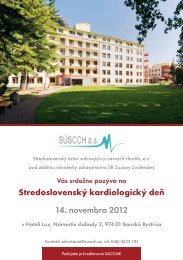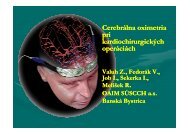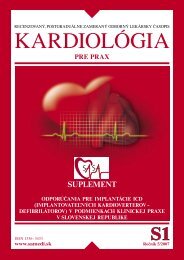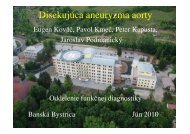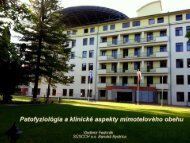Management of acute myocardial infarction in patients presenting ...
Management of acute myocardial infarction in patients presenting ...
Management of acute myocardial infarction in patients presenting ...
You also want an ePaper? Increase the reach of your titles
YUMPU automatically turns print PDFs into web optimized ePapers that Google loves.
ESC Guidel<strong>in</strong>es 2913<br />
2. The pathogenesis <strong>of</strong> ST-segment<br />
elevation <strong>acute</strong> <strong>myocardial</strong> <strong><strong>in</strong>farction</strong><br />
Most cases <strong>of</strong> STEMI are caused by an occlusion <strong>of</strong> a major coronary<br />
artery. Coronary occlusion and reduction <strong>in</strong> coronary blood<br />
flow are usually due to physical disruption <strong>of</strong> an atherosclerotic<br />
plaque with subsequent formation <strong>of</strong> an occlud<strong>in</strong>g thrombus.<br />
Concomitant coronary vasoconstriction and microembolization<br />
may be <strong>in</strong>volved to some extent. Less commonly a thrombus<br />
may form from a superficial erosion <strong>of</strong> the endothelial surface.<br />
The risk <strong>of</strong> plaque disruption depends on plaque composition<br />
and vulnerability (plaque type) and degree <strong>of</strong> stenosis (plaque<br />
size). 3 As many as three-quarters <strong>of</strong> all <strong>in</strong>farct-related thrombi<br />
appear to evolve over plaques caus<strong>in</strong>g only mild to moderate stenosis.<br />
Even portions <strong>of</strong> the coronary arterial tree that appear<br />
normal by angiographic criteria <strong>of</strong>ten harbour a substantial<br />
burden <strong>of</strong> atherosclerosis. In particular, plaques with substantial<br />
outward remodell<strong>in</strong>g, or ‘compensatory enlargement’, can have<br />
th<strong>in</strong>, fibrous caps and large lipid pools without encroachment <strong>of</strong><br />
the lumen. 4 However, severe stenoses are as likely to undergo<br />
plaque events lead<strong>in</strong>g to <strong><strong>in</strong>farction</strong> as mild ones. 5 There is frequently<br />
a delay (up to 2 weeks) between the rupture <strong>of</strong> a<br />
plaque and its cl<strong>in</strong>ical consequences. 6 Inflammation plays an<br />
important role <strong>in</strong> plaque <strong>in</strong>stability, and therefore <strong>in</strong> the pathogenesis<br />
<strong>of</strong> <strong>acute</strong> coronary syndromes. Circulat<strong>in</strong>g levels <strong>of</strong> <strong>in</strong>flammatory<br />
markers such as C-reactive prote<strong>in</strong> (CRP) and <strong>in</strong>terleuk<strong>in</strong>-6<br />
are correlat<strong>in</strong>g with the cl<strong>in</strong>ical course and outcome <strong>of</strong> an <strong>acute</strong><br />
coronary syndrome. 7–9<br />
The circadian variation <strong>of</strong> STEMI with a higher <strong>in</strong>cidence <strong>in</strong> the<br />
early morn<strong>in</strong>g hours can be expla<strong>in</strong>ed by the comb<strong>in</strong>ation <strong>of</strong><br />
b-adrenergic stimulation (<strong>in</strong>creased vascular tone and blood<br />
pressure), hypercoagulability <strong>of</strong> the blood, and hyper-reactivity <strong>of</strong><br />
platelets. Activities associated with <strong>in</strong>creased sympathetic stimulation<br />
and vasoconstriction, such as physical or emotional stress,<br />
may also trigger plaque disruption and coronary thrombosis. 10<br />
Myocardial necrosis caused by complete coronary artery occlusion<br />
beg<strong>in</strong>s to develop after 15–30 m<strong>in</strong> <strong>of</strong> severe ischaemia (no<br />
forward or collateral flow) and progresses from the subendocardium<br />
to the subepicardium <strong>in</strong> a time-dependent fashion (‘the wavefront<br />
phenomenon’). Reperfusion, <strong>in</strong>clud<strong>in</strong>g recruitment <strong>of</strong> collaterals,<br />
may save myocardium at risk from undergo<strong>in</strong>g necrosis,<br />
and subcritical but persistent forward flow may extend the time<br />
w<strong>in</strong>dow for achiev<strong>in</strong>g <strong>myocardial</strong> salvage.<br />
The thrombotic response to plaque disruption is dynamic: thrombosis<br />
and clot lysis, <strong>of</strong>ten associated with vasospasm, occur simultaneously,<br />
and may cause <strong>in</strong>termittent flow obstruction and distal<br />
embolization. 11 The absence <strong>of</strong> complete heal<strong>in</strong>g <strong>of</strong> an age<strong>in</strong>g<br />
plaque (<strong>in</strong>complete re-endothelialization) and thrombus formation<br />
play an important role <strong>in</strong> the occurrence <strong>of</strong> sudden occlusive<br />
coronary thrombosis. In 25–30% <strong>of</strong> <strong>patients</strong> undergo<strong>in</strong>g primary<br />
percutaneous <strong>in</strong>tervention (PCI), <strong>in</strong>itial angiography shows a<br />
patent <strong>in</strong>farct-related artery. 12 In these <strong>patients</strong>, it is presumed that<br />
spontaneous, endogenous lysis occurred before angiography.<br />
Both platelets and fibr<strong>in</strong> are <strong>in</strong>volved <strong>in</strong> the evolution <strong>of</strong> a persist<strong>in</strong>g<br />
coronary thrombus. Whereas platelet adhesion and aggregation<br />
<strong>in</strong>itiate mural thrombus formation, fibr<strong>in</strong> is important for the<br />
subsequent stabilization <strong>of</strong> the early and fragile platelet thrombus.<br />
3. The natural history <strong>of</strong> STEMI<br />
The true natural history <strong>of</strong> STEMI is hard to establish for a<br />
number <strong>of</strong> reasons: the common occurrence <strong>of</strong> silent <strong><strong>in</strong>farction</strong>,<br />
the frequency <strong>of</strong> sudden death outside the hospital, and the<br />
vary<strong>in</strong>g methods and def<strong>in</strong>itions used <strong>in</strong> the diagnosis <strong>of</strong> the<br />
condition. Community studies have consistently shown that the<br />
overall case fatality rate <strong>of</strong> <strong>patients</strong> with presumed <strong>myocardial</strong><br />
<strong><strong>in</strong>farction</strong> or <strong>acute</strong> coronary syndrome <strong>in</strong> the first month is<br />
50%, and <strong>of</strong> these deaths about half occur with<strong>in</strong> the first<br />
2h. 13 This high <strong>in</strong>itial mortality seems to have altered little<br />
over the last years <strong>in</strong> contrast to hospital mortality. 14 In contrast<br />
to community mortality, there has been a pr<strong>of</strong>ound fall <strong>in</strong> the<br />
fatality <strong>of</strong> <strong>patients</strong> treated <strong>in</strong> hospital. Prior to the <strong>in</strong>troduction<br />
<strong>of</strong> coronary care units <strong>in</strong> the 1960s, the <strong>in</strong>-hospital mortality<br />
seems to have averaged 25–30%. A systematic review <strong>of</strong> mortality<br />
studies <strong>in</strong> the pre-reperfusion era <strong>of</strong> the mid-1980s<br />
showed an average <strong>in</strong>-hospital fatality <strong>of</strong> 16%. With the widespread<br />
use <strong>of</strong> coronary <strong>in</strong>terventions, fibr<strong>in</strong>olytic agents, antithrombotic<br />
therapy, and secondary prevention, the overall<br />
1-month mortality has s<strong>in</strong>ce been reduced to 4–6%, at least<br />
<strong>in</strong> those who participated <strong>in</strong> the latest randomized large-scale<br />
trials and qualified for fibr<strong>in</strong>olysis and/or coronary <strong>in</strong>terventions.<br />
15,16 However, mortality rates <strong>in</strong> registry studies are<br />
much higher, suggest<strong>in</strong>g that the <strong>patients</strong> <strong>in</strong>cluded <strong>in</strong> the randomized<br />
studies 17 are at a lower risk when compared with<br />
those seen <strong>in</strong> the real world.<br />
C. First medical contact<br />
and emergency care flow<br />
Optimal treatment <strong>of</strong> STEMI should be based on the implementation<br />
<strong>of</strong> an emergency medical system (EMS) supervis<strong>in</strong>g a<br />
network between hospitals with various levels <strong>of</strong> technology, connected<br />
by an efficient ambulance (or helicopter) service (Figure 1).<br />
Figure 1 Pre-hospital management. EMS ¼ emergency medical<br />
system; STEMI ¼ <strong>acute</strong> ST-segment elevation <strong>myocardial</strong> <strong><strong>in</strong>farction</strong>;<br />
GP ¼ general practitioner; PCI ¼ percutaneous coronary<br />
<strong>in</strong>tervention. Thick arrows ¼ preferred patient flow; dotted<br />
l<strong>in</strong>e ¼ to be avoided.



